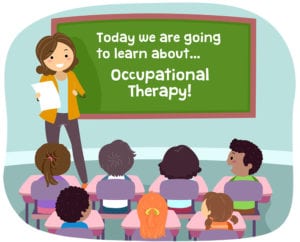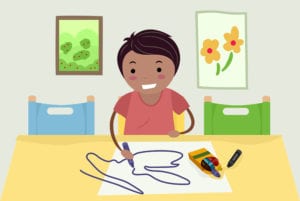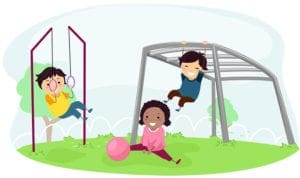As a teacher, you have an important role in recognizing your students’ strengths along with their areas of need. You want your students to be successful and to continue to make progress each day. As a teacher, you have a pivotal role in identifying students that may benefit from occupational therapy. But do you know the signs? Below are some characteristics of students who would benefit from receiving occupational therapy.
Fine and Visual Motor Deficits
Fine motor skills are the ability to use the small muscles in our hands, wrists, and fingers to produce movements. Visual motor skills include the coordination of motor skills with the visual information that is perceived and processed. Fine and visual motor skills are essential for completing school-related tasks.
What to look for:
- Difficulty holding a writing utensil
- Difficulty with letter formation and legibility
- Difficulty with scissor skills
- Difficulty coloring within the lines
- Difficulty copying geometric shapes or numbers
- Difficulty manipulating toys and puzzles
Difficulty with Visual Processing and Oculomotor Skills
Visual processing is the process in which our brain interprets visual information as we make sense of what we see. Oculomotor skills are the coordinated eye movements which allow us to scan, track, and fixate on objects.
What to look for:
- Difficulty with the spacing and sizing of letters when handwriting
- Difficulty recognizing letters, shapes, or numbers
- Difficulty copying shapes, letters, or numbers
- Difficulty finding objects among other objects
- Difficulty with visual tracking
- Difficulty with reading
- Difficulty with copying from the board or another paper
Difficulty with Executive Functioning
Executive functioning is higher-level mental processes that allow a person to plan, focus, remember directions, regulate emotions, initiate tasks, organize, and multitask. A student who is struggling with executive functioning may having difficulty attending, following multi-step directions, and completing homework or projects.
What to look for:
- Difficulty organizing desk or folders
- Frequently forgets to complete homework assignments
- Difficulty attending to tasks
- Difficulty following multi-step instructions
- Difficulty remembering directions
- Difficulty initiating a project or class assignment
- Poor time management
- Poor impulse control
Decreased Gross Motor Skills
Gross motor skills allow people to coordinate their arms, legs, and other body parts. Gross motor skills involve larger muscles that help us control our bodies. A child who has difficulty with gross motor skills may appear uncoordinated, show decreased strength, and/or balance.
What to look for:
- Slouches in his or her chair
- Rests head in hand while at the table
- Difficulty keeping up in gym class or at recess
- W-sits when seated on the floor during play or circle time
- Poor balance
- Poor coordination of both sides of the body
- Difficulty with ball skills
Difficulty with Sensory Processing
Sensory processing refers to the way a person’s nervous system receives input from the senses; processes and organizes the input; and demonstrates an appropriate motor and behavioral response. Challenges with sensory processing can impact your students’ engagement in everyday tasks and routines.
What to look for:
- Fidgety and difficulty sitting still in a chair or at circle time
- Seeks out significant tactile, proprioceptive, vestibular, visual, oral, movement, and/or auditory input. This might look like: crashing into objects, cuddling, hugging, making noise, spinning, or a desire to touch everything
- Decreased attention and/or inability to maintain focus for an age-appropriate amount of time.
- Is hypersensitive to sounds, touch, or movement
- Underresponsive to certain sensations (i.e., doesn’t notice bruises, high pain tolerance)
- Oblivious to the environment
- Gravitational Insecurity – fearful of feet leaving the ground. This may be seen during recess as the child may avoid the slide, swings, or climbing activities
- Inability to calm self when upset
- Frequently bumps into things or seem clumsy
Difficulty with Activities of Daily Living
Activities of daily living (ADLs) are activities related to self-care which include dressing, bathing, grooming, feeding, and toileting.
What to look for:
- Unable to don/doff clothing at an age-appropriate level
- Unable to manipulate clothing fasteners at an age-appropriate level
- Difficulty with using utensils during lunch or snack time
- Difficulty following his or her bathroom routine
If you see your students having any of the challenges listed above, they will most likely benefit from an occupational therapy evaluation. Being able to recognize these difficulties will allow you to help your student get the support they need to grow and be successful in the classroom. For additional information, please download Chicago Occupational Therapy’s book, Signs your Students Might Benefit from Occupational Therapy.
Contact Chicago Occupational Therapy or call (773) 980-0300 to learn more about our services and how we can help your child flourish and grow.




